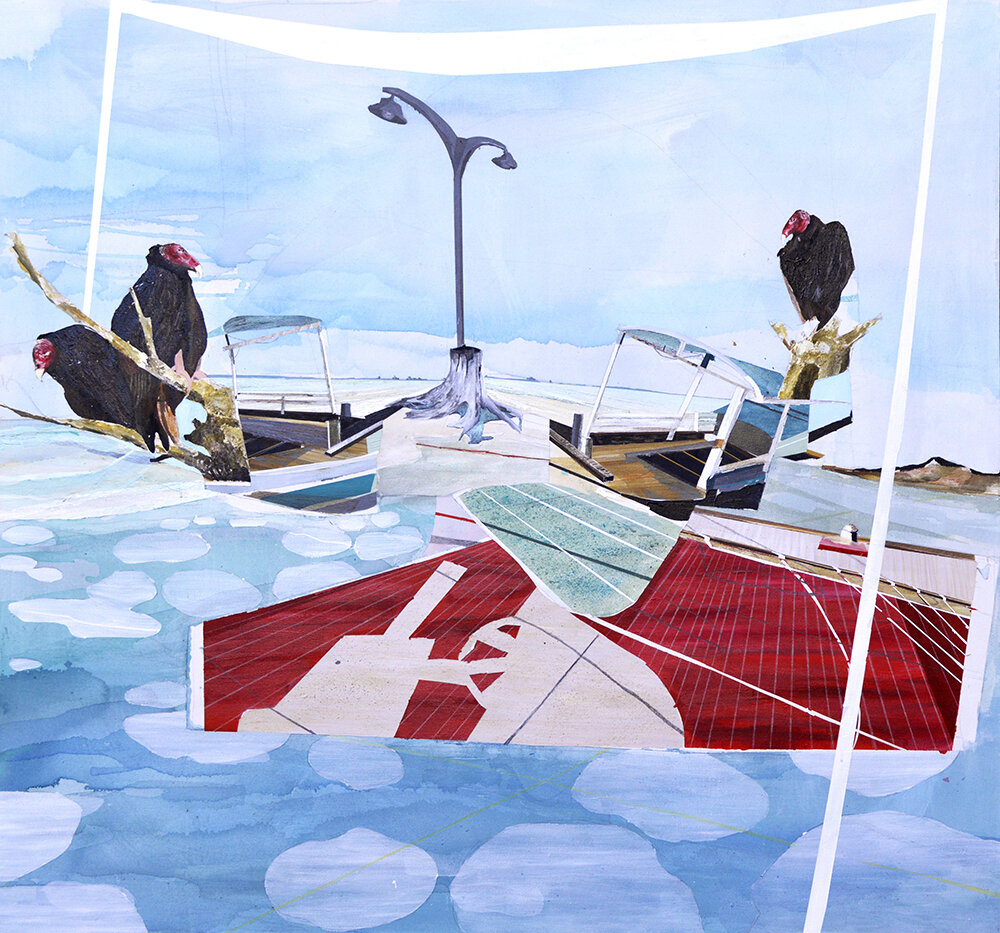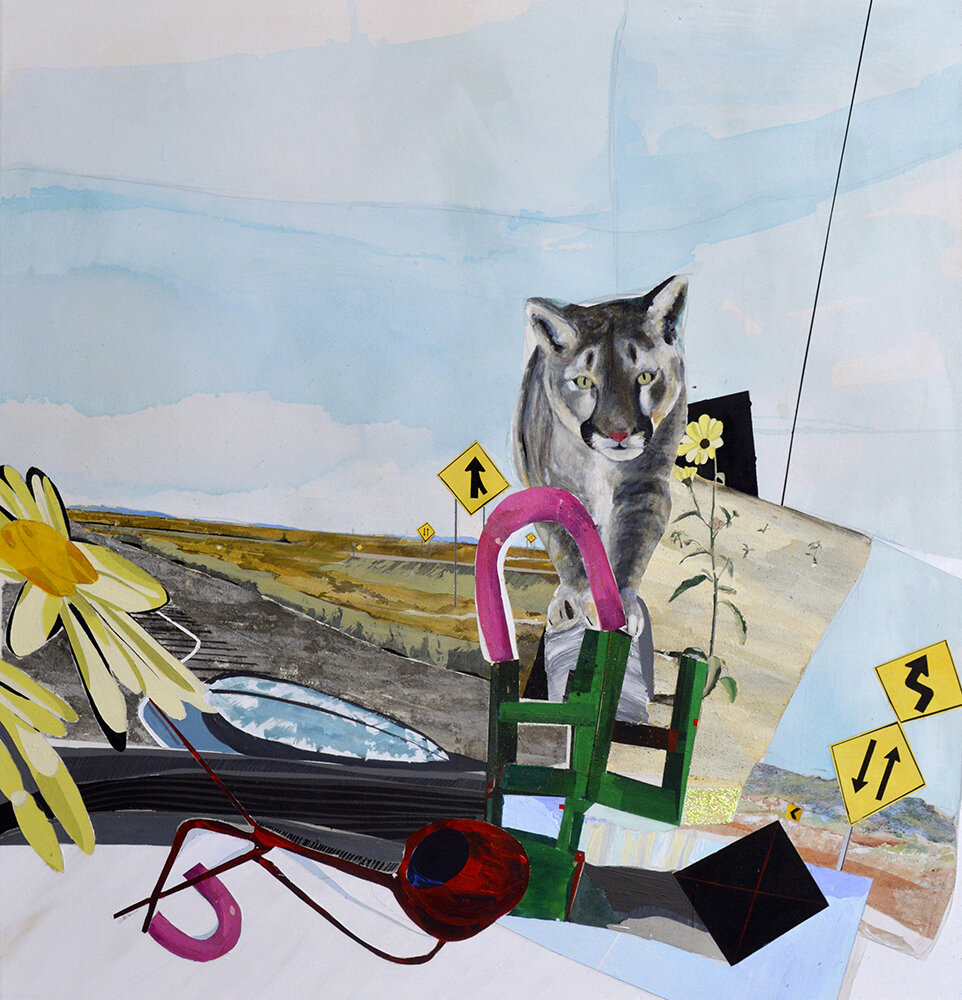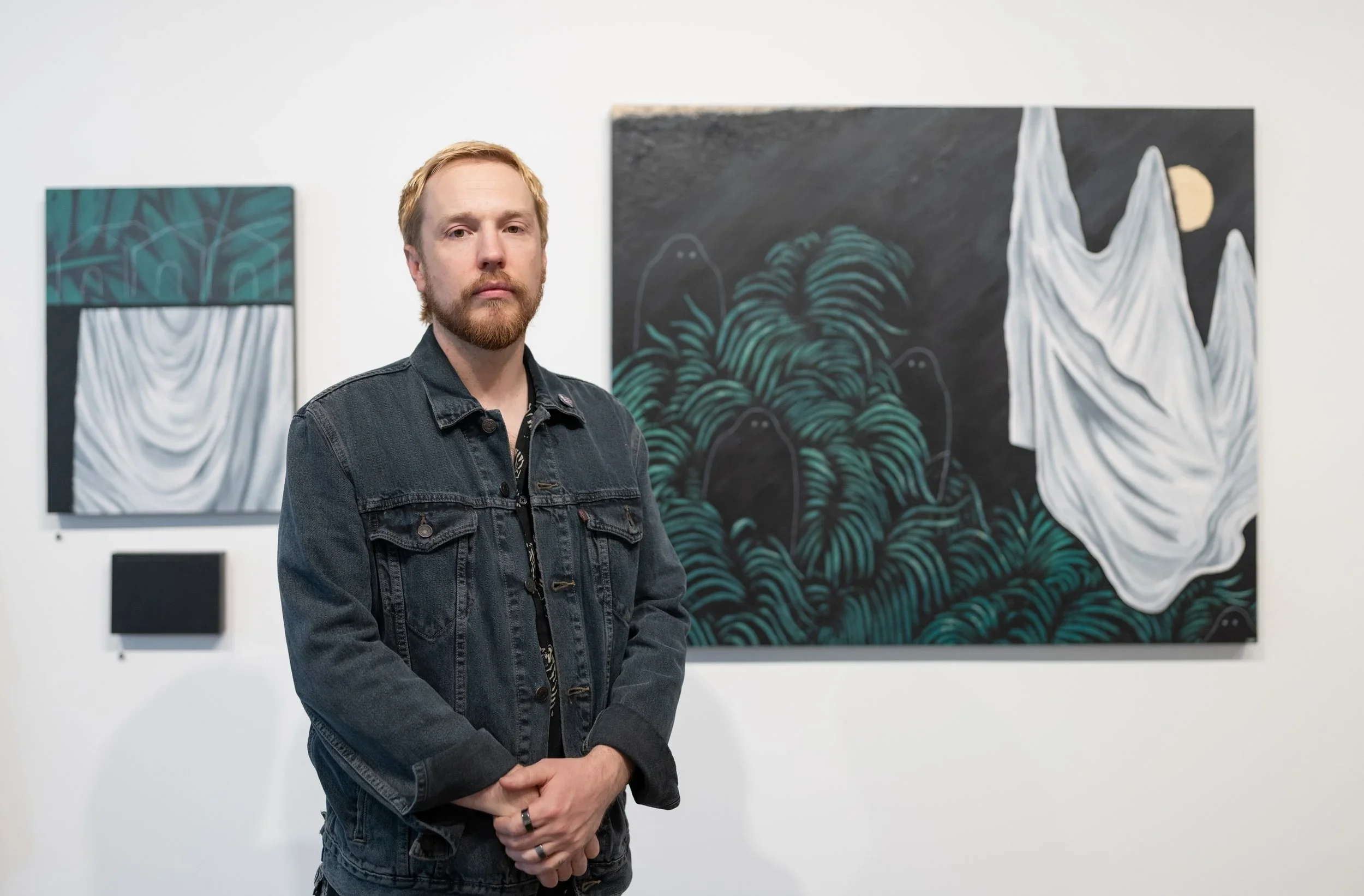10 Questions with Jenny Day
Jenny Day (1981) is a painter who lives in Santa Fe, New Mexico. She earned an MFA in Painting from the University of Arizona, a BFA in Painting from the University of Alaska Fairbanks, and a BA in Environmental Studies from the University of California Santa Cruz.
How many ways can one approach mourning? Jenny Day has tried to jest at it, deconstruct it, cover loss in trashy glamour and glitter, and reassemble it, so the source material is only hinted at—an assemblage of Instagram snippets and sad wry and sour jokes and heartbreak.
Still, loss cuts through everything. Jenny Day keeps trying to title paintings Failed Utopia. "Used that one already," her husband says, "or some variant of it. You want to name every painting." And (she considers it true*) it's true. California is omnipresent, a grounding, overlaid with other landscapes, Utah, Cambodian beaches, Dubai. Misplaced animals stand as totemic witnesses to a world eroded by an accumulation of insults, both large and small. And Jenny Day is letting go of the hope of ever seeing it any other way. Damaged landscapes, pulled apart, puzzled over, persevering with a litany of scars.
Painting as a protest when she has already admitted defeat. The good guys lost, it gets hotter every year, and Jenny Day will drive home from the opening in her SUV, V8 engine rumbling because it sometimes snows where she lives. Due to the difference, it would make. It could have been better than this. Jenny Day wants to say we've given up. Sometimes it feels like we never even tried.
Her exhibition record most recently includes Arte Laguna in Venice, Italy; Czong Institute for Contemporary Art in Korea; Phoenix Art Museum, Blue Star Contemporary Museum in San Antonio, TX, and Elmhurst Museum in Chicago, IL. An Elizabeth Greenshields Foundation Grant supported day's work in 2018, a Contemporary Forum Artist Grant from the Phoenix Art Museum in 2017, a Barron Purchase Award in 2016, and through participation at Greenwich House Pottery, the Ucross Foundation, the Jentel Foundation, and the Playa Foundation For The Arts, among others. Jenny Day is represented by Jonathan Ferrara Gallery in New Orleans, Louisiana, Davis Dominguez Gallery in Tucson, Arizona, and William Havu Gallery in Denver, Colorado.
INTERVIEW
Jenny Day, Welcome to Al-Tiba9. Could you tell us a little more about your background, and how did you begin creating art?
I grew up in California and studied Environmental Science at the University of California Santa Cruz. After that, I lived out of my truck in Maine and worked various jobs; farmer, landscaper, and hospice worker. I was restless, constantly moving, living in small cabins and yurts.
I did not take my creative pursuits seriously until I went to school for a Bachelor of Fine Arts degree at the University of Alaska in 2005. I dabbled. I learned how to weld, make knives, and studied blacksmithing, printmaking, and sculpture. I was drawn to painting, but I avoided it. I eventually let myself paint and loved it. I worked full-time and went to school at night. Painting was all I wanted to do.
In 2014, I received my Masters of Fine Arts in Painting at the University of Arizona. The first year I painted over everything I made. I reexamined myself and my work, shaping it into something smarter, better. Graduate school situated my work in art history taught me to make informed decisions in my paintings, and the confidence to reject what was redundant in my work.
Currently, I live in Santa Fe, New Mexico, and am a full-time artist.
Could you tell our readers how you define yourself as an artist?
I am a painter, and I make mixed media paintings on canvas. My work examines the world through a lens of loss and humor. My paintings are informed by current events, environmental degradation, and politics. I paint damaged landscapes, pulled apart, puzzled over, persevering with a litany of scars.
Bifurcated translation, Jenny Day©
Do you have an essential concept that guides you in your creative expression?
To be vulnerable about issues that are important or uncomfortable and inject my work with honesty and humor.
What do you hope that the public takes away from your art?
I hope that the work asks questions instead of providing answers and that viewing the work produces simultaneous conflicting feelings. I want people to walk away from my paintings, reexamining our role in the environment, with each other, and ourselves.
happy cows equine ghosts, Jenny Day©
Which of your artworks has given you the most satisfaction?
I am not someone who will ever be satisfied. The best part of painting is losing track of time and being present in the work. A painting never feels finished. It is a relentless quest.
What is your creative process like?
I create collages to use as a reference in a painting. I photograph, print, and draw on them. Then I repeat and digitally manipulate them, repeat, and add more collage elements. Eventually, I come up with something worthy of a painting or sculpture.
Recently, I have become mesmerized by videos of trick-riders on horses and news footage of natural disasters. I read about toxic algae blooms from agricultural runoff, effects of fire retardant on wildlife, and photoreceptor cells of alligators in swamps. I listen to podcasts and audiobooks while I work, learning about oil spills, the history of logging in America, and boom-bust cycles of the Texas Panhandle. It all informs my work.
Miscalibration sacred profane, Jenny Day©
I use anything that can make a mark in my paintings, including; acrylic paint, spray paint, ink, highlighters, paint pens, crayons, pencils, etc. I make paint skins, cut them up, and adhere them onto my paintings. I test out how far I can take a surface from one extreme to another, using staining techniques and chunky layers of glued on paint. Recently, I have begun to mix my own paint with pigment and additives.
You are selected as a finalist artist in Arte Laguna Prize in Venice, Italy to show your work in the Arsenale, venue of the well-known Venice Biennale. What does this mean for you as an artist?
My work was exhibited in Arte Laguna in 2018 and 2020. In 2018, I visited the exhibition and was amazed by how large the venue was. Having my work accepted into Arte Laguna has pushed me to take greater risks in paintings. Arte Laguna has expanded my art community.
Besides being a talented and creative person, you are also very curious and thirsty for learning new things every day. How do you keep yourself up to date with the latest trends and technologies that have today a significant impact on artistic productions?
I keep myself up to date by seeing exhibitions, connecting with other artists, and researching topics that interest me.
In your opinion, what makes the freedom of an artist?
My experience as an artist has allowed me to practice patience, become comfortable taking creative risks, and accept failure and rejection. Good art comes from pushing boundaries and reflecting on what is happening around you.
Finally, Are there any projects you are currently working on and able to speak about?
I am working on exhibitions for 2021 and 2022. In 2021, I will have a solo exhibition at the Alabama Art Center, which includes large paintings and ceramic sculptures. The pieces in the exhibition will act as monuments, made in humor and sorrow, a nod to a time when even our most serious problems are met with unserious responses. A merging of disaster and memory. Epic narratives that are turbulent, violent, and mythic. In the fall of 2021, I will attend a ceramic residency at Greenwich House Pottery in New York City.
Maximum Saturation, Jenny Day©


























